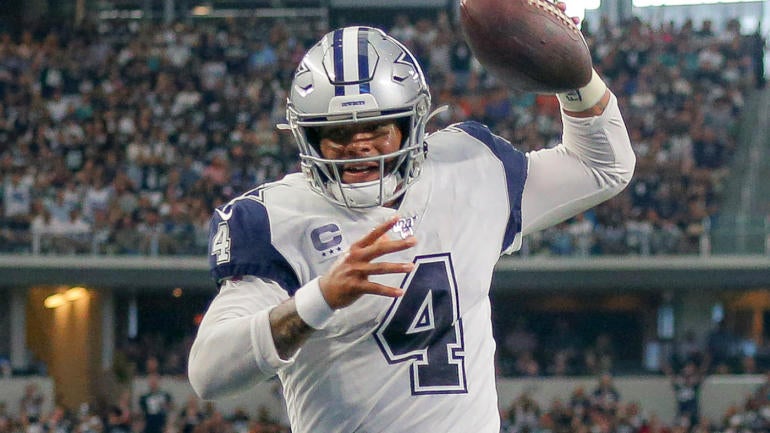
Use of franchise player designations increased dramatically this year. More players were given franchise tags than over the last two years combined. Fourteen players received franchise tags while 11 designations were used collectively in 2018 and 2019. Usage hasn't been this high since a record 21 teams placed the designation on players in 2012, when there was almost a 20 percent drop in the franchise tender amounts from 2011 as the method of calculating these figures changed.
Teams will probably be more judicious with the franchise player designation out of necessity in 2021. The NFL and NFLPA have set a $175 million salary cap floor for 2021 with league revenues declining due to COVID-19. Placing a franchise tag on someone may be a luxury that a majority of teams can't afford.
A look at how franchise tags work is below. The projected 2021 franchise numbers and an examination of the best candidates to receive the designations next year follows.
Franchise tag logistics
NFL teams can retain the rights to one of its impending free agents in 2021 with the use of a non-exclusive or an exclusive franchise tag during a 15 day period from Feb. 23 to March 9.
There is some confusion on how franchise tenders are calculated. Prior to the 2011 Collective Bargaining Agreement, non-exclusive franchise tags had been an average of the five largest salaries in the prior year at a player's position or 120 percent of the prior year's salary of the player, whichever was greater. For franchise tag purposes, salary means a player's salary cap number, excluding workout bonuses and most other performance bonuses.
The 120 percent and five largest salaries provisions have remained intact but the formula component is now calculated over a five year period that's tied to a percentage of the overall salary cap. More specifically, the number for each position is determined by taking the sum of the non-exclusive franchise tags as determined by the original methodology for the previous five seasons and dividing by the sum of the actual NFL salary cap amount for the previous five seasons. The resulting percentage, which is known as the Cap Percentage Average in the CBA, is then multiplied by the actual salary cap for the upcoming league year.
This non-exclusive tag allows a player to negotiate with other NFL teams but if he signs an offer sheet with another club, his team has five days to match the offer. If the offer is not matched, his team will receive two first round picks as compensation from the signing team.
Under the exclusive franchise tag, a player will receive a one year offer from his team that is the greater of the average of the top five salaries at his position once the restricted free agent signing period of the current league year has ended (April 23 for 2021) or 120 percent of his prior year's salary. The non-exclusive number is initially used as placeholder and adjusted upwards if the exclusive calculation dictates once restricted free agency ends. A player cannot negotiate with other teams with the exclusive franchise tag.
The transition tag has been used with less frequency than the franchise tag. It is based on the average of the top 10 salaries at a player's position using the same methodology as non-exclusive franchise tag calculations. The 120 percent provision also applies. Teams have the same right of first refusal as with franchise tags but do not receive any draft choice compensation for declining to match an offer sheet.
2021 tag projections
The chart below contains an early look at the 2021 franchise tags. I keep track of the salary data necessary to do the calculations under the franchise and transition tag formulas. I recently confirmed with my NFL sources the 2020 data entering the formula. The tags numbers are preliminary because the numbers can't be finalized until the 2021 salary cap is set in late February or early March.
The $175 million salary cap floor is being used to calculate the figures. If revenues are better than expected, the 2021 salary cap could be higher but will likely remain below the current level of $198.2 million.
| Position | Current | Projected | % change |
|---|---|---|---|
Cornerback | $16,338,000 | $14,441,000 | -11.61% |
Defensive end | $17,788,000 | $15,409,000 | -13.37% |
Defensive tackle | $16,126,000 | $13,317,000 | -17.42% |
Linebacker | $15,828,000 | $14,184,000 | -10.39% |
Offensive line | $14,781,000 | $13,188,000 | -10.78% |
Punter/kicker | $5,019,000 | $4,298,000 | -14.37% |
Quarterback | $26,824,000 | $24,072,000 | -10.26% |
Running back | $10,278,000 | $8,300,000 | -19.24% |
Safety | $11,441,000 | $10,176,000 | -11.06% |
Tight end | $10,607,000 | $9,206,000 | -13.21% |
Wide receiver | $17,865,000 | $15,326,000 | -14.21% |
Top 2021 candidates
By CBA rule, the players currently under a one year franchise tag, like Cowboys quarterback Dak Prescott, are prohibited from signing long term until the regular season ends. The 49ers are precluded from designating offensive tackle Trent Williams, who was acquired from the Washington Football Team during the 2020 NFL Draft, as a franchise or transition player. His contract was reworked during the offseason to include a clause preventing either tag.
The Eagles, Falcons, Packers, Rams, Saints, Steelers are among the teams that will be hard pressed to use a designation because of challenging salary cap situations next year. Each team currently has more than $198.2 million in 2021 salary cap commitments according to NFLPA data. The Eagles and Saints have just under $263.16 million and a little more than $283.15 million respectively.
Prescott is playing this season on a $31.409 million franchise tag because of an inability to reach a long term agreement with the Cowboys. He was having the best year of his career when he sustained an open or compound fracture and dislocation of his right ankle against the Giants five games into the season. Through the quarter mark, Prescott was on pace to shatter Peyton Manning's NFL single season passing yards record (5,477). Prescott was projecting to 6,760 passing yards for the season. He also completed a career high 68 percent of his passes in the five games he played.
Cowboys owner Jerry Jones has indicated that Prescott's injury doesn't change Dallas' plans for him. A second franchise tag in 2021 for $37,690,800 at the CBA mandated 20 percent raise was an absolute certainty before Prescott got hurt. Signing Prescott to a long term deal will likely cost the Cowboys more than the four year, $156 million contract extension averaging $39 million per year Deshaun Watson received from the Texans as the start of the regular season was approaching.
Things would get really interesting if Prescott played the 2021 season on another franchise tag. Prescott would become an unrestricted free agent in 2022 or receive a third franchise tag at a 44 percent increase over the 2021 figure for $54,274,752.
A lack of interest after Newton's release by the Panthers in March led him to sign a one-year deal with a base value of $1.75 million worth up to $7.5 million through incentives. Newton has had mixed results in trying to resurrect his career after being plagued by foot and shoulder injuries over the last two seasons. He got off to a hot start this season before testing positive for COVID-19. Newton performed so poorly initially upon returning to action from the coronavirus he admitted he could be benched with continued subpar performances, which have subsided. Nobody is going to confuse the current Newton with the 2015 NFL MVP version. Nonetheless, a franchise tag could make sense because the Patriots are in great shape with the salary cap for next year, the 2021 free agent quarterback class is underwhelming and a second franchise tag for offensive guard Joe Thuney would be $17,737,200.
Talks between Robinson and the Bears failing to produce a new contract led to rumors of him requesting a trade. Robinson surely took note of the four-year extension wide receiver Keenan Allen received from the Chargers in early September averaging $20.25 million per year with $50 million of guarantees. He is on track for 103 receptions and 1,206 receiving yards, which would be his best marks with the Bears, despite shaky quarterback play. It will cost the Bears $17.88 million to franchise Robinson because of the 120 percent of prior year's salary provisions. The caliber of a team's quarterback could be an extremely important consideration for Robinson should he become an unrestricted free agent.
Barrett being one of the biggest surprises of 2019 led to him getting the $15.828 million franchise tag for linebackers from the Buccaneers. He had a league leading 19.5 sacks last season. Duplicating that kind of season wasn't expected. Barrett has a respectable six sacks in 12 games this season. A second franchise tag in 2021 would be $18,993,600, but allow Pro Bowl wide receiver Chris Godwin to hit the open market.
Godwin had a breakout 2019 season in which he caught 86 passes for 1,333 receiving yards with nine touchdowns despite missing the final two games with a hamstring injury. He was named to his first Pro Bowl and earned second team All-Pro honors. Godwin has been slowed by assorted injuries this season (concussion, hamstring, broken finger) but still has 49 catches for 562 yards in eight games. There probably isn't a deal to made with Godwin to remain a Buccaneer if he doesn't easily surpass Mike Evans as Tampa Bay's highest paid wide receiver. Evans signed a five year extension in 2018 averaging $16.5 million per year with $55.008 million in guarantees.
Trying to retain Scherff, who is playing under a $15.03 million franchise tag, could take on additional importance after trading a disgruntled Trent Williams to the 49ers. The three-time Pro Bowler has missed three games this season with a sprained right MCL. The injury landed Scherff on injured reserve for his third straight year. Ensuring that Scherff stays in Washington will likely require a long term contract at least making him the NFL's first $15 million per year interior offensive lineman. A second franchise tag in 2021 with a 20 percent raise is going to be $18.036 million.
Ngakoue made it abundantly clear he wasn't going to continue playing for the Jaguars after being designated as franchise player for $17.788 million. He wanted out Jacksonville so badly he put his money where his mouth is. In order to facilitate a trade to the Vikings, Ngakoue took over a 30 percent pay cut from his unsigned $17.788 million franchise tender. He is making $12 million to play this season. Ngakoue was subsequently traded to the Ravens six games into the season.
The Ravens could lose both of their edge rushers, Ngakoue and Matthew Judon, without preventing one from hitting the open market. It will be cheaper to restrict Ngakoue than Judon, who is playing this season for $16.808 million after being named as Baltimore's franchise player. A second franchise tag for Ngakoue will be $15.409 million and $20,169,600 for Judon.
Ngakoue was reportedly looking to top $20 million per year when negotiating with the Jaguars in 2019 before playing out his rookie contract. Defensive ends Joey Bosa and Myles Garrett raising the bar for pass rushers with $27 million per year and $25 million per year deals from the Chargers and Browns respectively likely only confirms Ngakoue's financial demands.
Hip and hamstring injuries have limited Golladay to five games this season. Keeping Golladay in the fold one way or another should be a top priority for the successors of recently fired general manager Bob Quinn and head coach Matt Patricia.
The Broncos placed an $11.441 million franchise tag on Simmons after a stellar 2019 in which he earned second team All-Pro honors. Simmons is playing at a Pro Bowl level this season. Offensive tackle Garett Bolles' new four-year extension reportedly worth $68 million puts a second franchise tag for $13,729,200 in play. Staying in Denver on a long term deal might make Simmons the NFL's highest paid safety. That distinction belongs to Budda Baker, who signed a four-year, $59 million extension averaging $14.75 million per year with the Cardinals in August.
Curiously, the Giants gave up a 2020 third round pick and a 2021 fifth round pick for Williams as last season's trading deadline was approaching when they had a better shot at the first overall pick in the 2020 Draft than securing a playoff berth. Giants general manager Dave Gettleman doubled down on Williams with a franchise tag for $16.126 million. Williams may not have been a hot commodity in free agency since he has yet to live up to the potential that made him 2015's sixth overall pick. 2020 is arguably having Williams' best season as a pro. A second franchise tag at $19,351,200 is more of a possibility if Gettleman keeps his job. Either way, Williams could be targeting Falcons defensive tackle Grady Jarrett ($17 million per year) or Packers nose tackle Kenny Clark ($17.5 million per year) as a salary floor because of his improved play.
Henry is making $10.607 million this season as a franchise player. A second franchise tag at $12,728,400 may be appealing for the Chargers to ensure that rookie quarterback Justin Herbert doesn't lose a weapon in the passing game. Whether Henry can benefit from 49ers tight end George Kittle dramatically re-setting the tight end market in August at $15 million per year remains to be seen. Although Henry isn't having a true breakout season, he is on pace for career highs of 70 receptions and 730 receiving yards. Henry probably would have been looking at a deal comparable to the four year, $42 million contract with $23 million in guarantees Austin Hooper received from the Browns in free agency if on the open market this year.
Moton can make a good case along with Jack Conklin for being the NFL's best right tackle this season. Conklin is the most recent data point for right tackles. He signed a three-year, $42 million contract containing $30 million fully guaranteed with the Browns in free agency this year. Lane Johnson (Eagles) is the league's highest paid right tackle at $18 million per year.





































